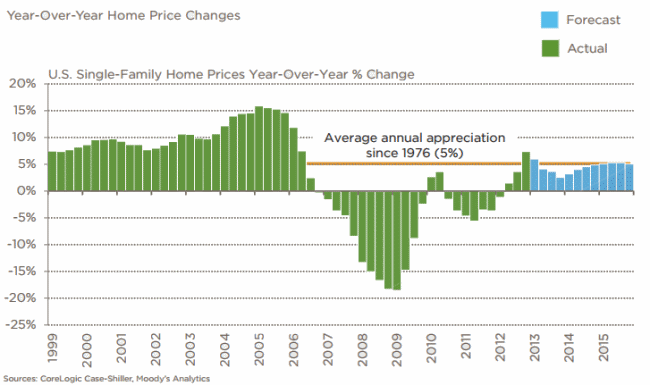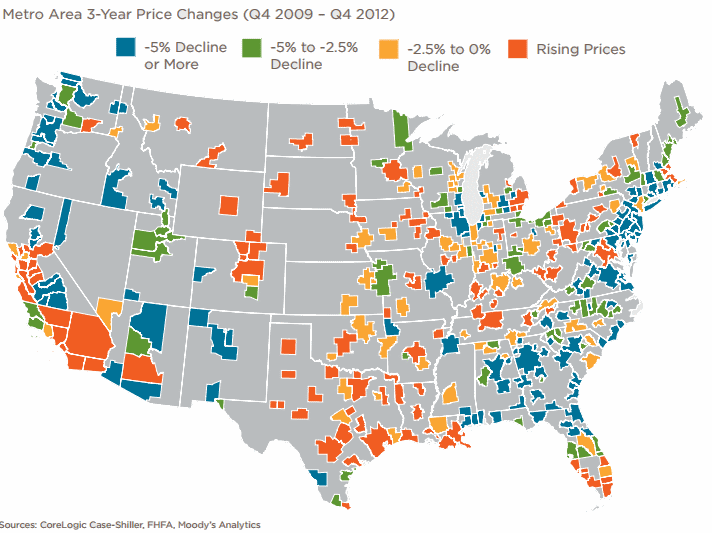CoreLogic said today that home prices are projected to increase 3.9 percent on an annualized basis between the fourth quarter of 2012 and the same quarter in 2017. However, a new housing bubble is not likely as market dynamics shift for both supply and demand. Prices rose 7.3 percent in 2012.
The CoreLogic Case-Shiller Index report notes that the increase in 2012 was the strongest rate of appreciation in nearly seven years and projected that prices will continue to improve in 2013 and beyond in the more than 380 U.S. markets it tracks. The company's current analysis says that, "Cities at epicenter of housing bubble/crash are clocking highest rate of appreciation, largely driven by investor demand."

"Home prices were up in seven out of every 10 metro areas in 2012. By comparison, in 2011 prices appreciated in fewer than one-in-five markets," said Dr. David Stiff, chief economist for CoreLogic Case-Shiller. "We expect strong buying activity this spring will lead to stabilization of home prices in most lagging markets, resulting in rising home prices in nearly every metro area by the end of 2013."
Some of the cities that were hit the hardest by the housing crash and resulting foreclosure epidemic are also recovering the fastest. Phoenix saw a year over year price gain of 24 percent, Miami 14 percent, and Las Vegas 13 percent. Dr. Stiff observed that demand in Phoenix is being driven primarily by investors. As prices rise, the profitability of investment properties will erode, dragging down investor demand.
Some areas which have lagged in their recovery saw price declines slow. These included Long Island, (-4 percent), Virginia Beach, Virginia (-2 percent), and Philadelphia (-1 percent).

CoreLogic said that while the data point to continuing price appreciation, the overall national rate of home price increases is projected to decelerate in 2013 from 2012 levels. The CoreLogic Case-Shiller Indexes project a 2.5 percent home price increase in 2013, as the market dynamic shifts again in bubble/crash metro areas. While homes in these markets are still significantly undervalued, the strong investor demand for foreclosed properties, record levels of housing affordability and other demand factors that have driven recent double-digit price gains are unlikely to persist throughout the year.
Price appreciation is also expected to contribute to an increased supply of available homes as owners who have been locked into their current homes due to negative equity or were just unwilling to sell at existing prices begin to list their homes for sale. This will tend to curtail the portion of price increases that have been fed by unmet demand.
Dr. Stiff tamped down concerns of another housing bubble. "Even if double-digit price appreciation were to continue in the former bubble metro areas, there is no reason to believe that new home price bubbles are forming. That's because single-family homes in these markets are still very affordable, even after last year's large price gains. Consider Phoenix, where home prices rose 27 percent since the market hit bottom in 2011, making it the strongest residential real estate market in the U.S. Yet, home prices there are still 45 percent below their 2006 peak," Stiff continued.
Stiff said some of the rebounding areas like Phoenix will likely see price volatility as all cash sales and investor demand retreat. "It is not clear if demand from first-time and trade-up buyers will immediately fill the void," he said, "as mortgage lending standards are still very strict and many consumers remain risk-averse. If non-investor demand ramps up too slowly, then recent double-digit price appreciation could decelerate suddenly or even turn negative for a few months."
The CoreLogic Case-Shiller Indexes, which include data covering thousands of ZIP codes, counties, metro areas and state markets, are owned and generated by CoreLogic with supplemental data from the Federal Housing Finance Administration.







